Let's be clear: the response to the HIV epidemic today has shifted dramatically since it was first identified as a crisis in 1981 and a viral epidemic in 1984. The crisis has gone from usually fatal, to, today, a chronic manageable disease. It also means that people living with HIV are living nearly the same lifespan as people without the virus. However, it's also true that stigma continues to hamper efforts to end the epidemic, to ensure access to prevention services for at-risk people, and access to medical care and medications for those with the disease.
And Michigan is not an outlier in the evolving perceptions of the epidemic either. In our state, as has happened nationally, there have been good changes, bad changes and downright ugly ones, too. Here's a breakdown of those items from 2019.
The Ugly
The HIV epidemic continues to disproportionately impact people of color, particularly transgender people of color and same-gender-loving men of color, and this is clearly shown Michigan's statistical trends represented in the Michigan Statewide HIV Surveillance Reports from 2019, 2018 and 2017. In 2017, men who have sex with men represented the most newly diagnosed cases with 448 diagnosed, along with 19 men who have sex with men and inject drugs. In 2016, those rates were 449 and 22 respectively.
The numbers also show a racial disparity in both who is at risk for and who is being diagnosed with HIV. Fifty-nine percent of those diagnosed with HIV in 2017 were black. This is up from 58 percent in 2016. Of the men diagnosed with HIV, 44 percent were black and six percent were Latino.
The transgender community is also over-represented in the diagnoses in Michigan. Twenty-two transgender individuals were diagnosed with HIV in 2017, up from 17 in 2016. Of those diagnosed, 16 were black transgender persons, up from 15 in 2016.
Collectively, the number of people living with HIV in Michigan is 16,218 — this number differs from diagnosed persons because a person could move to Michigan after a diagnosis in another state.
Of those in the state who are diagnosed, 82 percent are in care, and of those in care, 89 percent have attained viral suppression. Though there is no cure for HIV, viral suppression means a person has an undetectable viral load. That means the virus's capacity to cause harm to the infected person is restricted. This also serves as a prevention method, because in this state the virus cannot be transmitted.
The vast majority of people living with HIV are in Metro Detroit. In total, that's 10,384 persons living in an area that includes Lapeer, Macomb, Monroe, Oakland, St. Clair and Wayne counties. Wayne County and the city of Detroit represent 6,895 of those cases. Eighty-one percent of those living with HIV are in medical care in the Metro Detroit area, while 87 percent of those in care in the region are virally suppressed.
The numbers also show that rural counties in Michigan continue to struggle to help people living with HIV get access to HIV medical care. Berrien County has a 71 percent rate of people in care, up from 58 percent in 2016; Monroe County has 70 percent of people in care, down from 76 percent in 2016; Sanilac county has 59 percent of people in care, down from 71 percent in 2016; and Mecosta county has 64 percent of people in care, up from 50 percent in 2016. All of these statistics are dramatically lower than the state average of in-care percentages, which is over 80 percent.
Both sets of numbers point to dramatic social and racial barriers to accessing care in Michigan and raise serious concerns about the ability of the state to meet the federal and state goals of getting 90 percent of people living with HIV diagnosed, 90 percent of those diagnosed in medical care and 90 percent of those in care virally suppressed.
So here's the good news in the numbers: There was a 1 percent increase in the number of people in care from 2016. However, there was no change in the percent of people in care with an undetectable viral load.
 The In-Between
The In-Between
Michigan has been burdened by an onerous felony law applicable only to persons living with HIV since 1988. But earlier this year, legislation signed into law at the end of January by former Gov. Rick Snyder, changed the law.
Previously, Michigan law required disclosure of an HIV-positive status for any sexual penetration, 'however slight.' Courts had rejected medical defenses that a person who was virally suppressed posed no risk to a sexual partner, despite federal and state government reports. This resulted in many prison sentences for people who were HIV-positive and virally suppressed because they failed to tell their sexual partners, rather than because they posed a real and quantifiable threat to the other person.
That law is gone. In its place are four new criminal laws, three of which explicitly require a prosecutor to prove a person intended to cause harm to another person via their sexual activity. The laws also specify that oral sex is excluded from criminalized behavior, and they allow a defendant to prove they were virally suppressed and thus presented no risk to their sex partner.
Despite the new laws, those who violated the old law could still face prosecution and 15 years in prison if allegations are brought. In September, Kent County presented a clear case of this. Keisha, an HIV-positive transgender woman of color, was arrested on criminal charges for failing to disclose issued related to an incident that happened four years ago. Prosecutors said they were determined to pursue the charges, despite the change in the law and Keisha having had an undetectable viral load. The charges were dismissed when the other person involved didn't show up for a preliminary hearing.
Unfortunately, even with the progress of the new laws, they contain a catchall misdemeanor with which people can be charged if they engage in sexual activity with "reckless disregard." That phrase is not defined, which leaves a loophole that could still be exploited negatively and resulting not only in more HIV-related cases in the criminal justice system but the outing of people's HIV status.
The Good
With Gov. Gretchen Whitmer in office, the state systems are beginning to shift. Just two weeks ago, Whitmer, state health officials and advocates held a press conference to announce new initiatives to address Michigan's ongoing opioid crisis. The new plans include more access to treatment, a public relations campaign to reduce stigma for those seeking care for opioid addiction and increased syringe access programming in the state.
That last one, syringe access, specifically follows calls Whitmer made two years ago to address the potential for a massive HIV outbreak in northern Michigan related to contaminated syringes. At the time, Whitmer was in a heated primary campaign for Governor, and she "demanded [Snyder] free up state dollars to address a potential HIV outbreak among people who use drugs in 11 mostly rural northern Michigan counties," Between the Lines reported exclusively in November of 2017.
Those remarks were made after state officials revealed that 11 counties in Northern lower Michigan were in the top five percent of counties in the U.S. at risk for an intravenous drug use outbreak of the virus.










